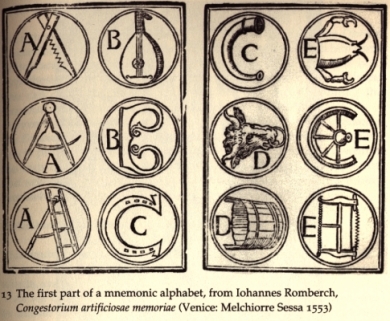Abracadabra: Language, Memory, Representation
Renaissance Arts of Memory
By the time of the printing press, the cultures of western Europe were in the midst of a swinging revival of ancient learning, including especially, the ancient techniques of rhetoric. One common argument about why memory systems disappeared (Yates herself makes it p.124) is that the book replaces the memory, and therefore makes elaborate systems unnecessary. This may be partially true, but it fails to explain why, from 1450 to 1700 there is a virtual explosion in treatises on memory systems. Even more bewildering, it fails to explin why people saw it necessary not only to print copies of memory treatises, but to illustrate them as well.
Some Renaissance Memory Treatises
Most Renaissance memory treatises are not exactly groundbreaking scholarly works. They are handbooks like our birder's fieldguide. They were most likely intended for use not by scholars but by professionals (recall that the ancient art of rhetoric and memory is used primarily for public speaking and persuasion: court cases, speaking before the assembly, arguing to go to war). Renaissance memory treatises were intended for theologians, preachers, professors, jurists, notaries, travelling philosophers, ambassadors and merchants.
Four representative treatises
- Jacobus Publicius, Oritoriae artis epitome
- Peter of Ravenna, Phoenix, sive artificiosa memoria (available in 17th c. English translation at eebo.)
- Johannes Romberch, Congestorium artificiose memorie
- Cosmas Rosselius, Thesaurus artificosae memoriae
Johannes Romberch
- c. 1520
- The cosmos as a memory locus
- The Abbey as memory locus
- The Human body as the proper size of memory
- Visual Alphabets
Romberch's book has four chapters; an intro, a section on places, a section on images, and a section on encyclopedic knowing. The places and images have been transformed somewhat in their new context of the Renaissance. Imaginary places like the cosmos are as good as real ones like the abbey. Strangely, there is a rule associated with human places, that the proper size is that of the human body. The image, like the famous Vitruvian Man by Da Vinci, resonates with other aspects of Renaissance Humanism.
The last chapter is perhaps the most interesting transformation, however. Why, all of a sudden is the memory system associated with Encyclodpedic learning? Why remember "everything"?
The period just after the introduction of the printing press can be conceived of as one of intense experiment with books. It might be hard to imagine, but it was not obvious what books were for, and there was little in the way of precedent. Memory systems, as technologies familiar to scholars and printers alike, served as a kind of template for organizing knowledge. This is perhaps one reason why there is such emphasis in Romberch on the visual alphabet and its use for remembering the arcanities of the various sciences (cf. the example of Grammatica in Yates, p. 119-20).

Romberch's visual alphabet, 1553